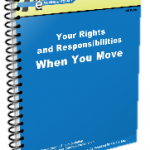Moving Tips – Be Prepared for a Moving Experience
Whether you’re preparing for a local move or a long distance move, there are several tried and true moving tips to get you ready for ‘The Move”. There are two main concepts to keep in mind when preparing for a move – less stuff means less to move; and you need to transport that less stuff from Point A to Point B safely.
Less Stuff
Now’s the time to clean house, literally and figuratively. Not only should you declutter if your home is on the market, but remove the clutter rather than pack it. To determine if an item is going to make the move ask these questions:
- Have I used this item in the past year?
- Do I love this item and have a specific use for it?
- Is this item in good condition and usable or have a value over $25?
- Does this item have significant sentimental value or family history attached?
If you answered yes to any of these questions, it’s either worth saving, worth selling or worth donating – the choice is yours. If you answered no, toss it.
Moving It
The stress of moving day is caused by not being completely packed and prepared. Packing supplies should be purchased 4-6 weeks in advance of the move. While using secondhand boxes is an inexpensive option, once a box is used, it loses 20% – 30% of its stability. Have new boxes in a variety of sizes on hand, along with packing tape, a marker, unprinted newspaper and bubble wrap to make packing easier and keep your items damage free.
Use the following guidelines to help estimate how many boxes you need to move:
- Studio Apartment: 10 small; 10 medium, 3 large, 1 dishpack and 1-2 wardrobe boxes;
- 1 Bedroom: 20 small; 20 medium; 5 large 1-2 dishpacks and 2-4 wardrobe boxes;
- 2 Bedrooms: 30 small; 30 medium; 10 large, 2-3 dishpacks and 4-8 wardrobe boxes;
- 3 Bedrooms: 35 small; 35 medium; 20 large, 3-4 dishpacks and 8-12 wardrobe boxes;.
- 4+ Bedrooms: 35 small, 40 medium, 30 large, 3-4 dishpacks and 12+ wardrobe boxes.
In addition to these boxes, make sure to have plenty of 30 mil, contractor grade trash bags on hand as well as 10 extra medium boxes for moving day. Trash bags can be used to pack comforters, pillows, sheets, etc.
More tips for a stress-free move:
- Mark boxes on sides and the top and list major contents.
- Use color coded labels to place on boxes according to which room they will go into in the new home.
- Pack valuables and important documents separately and leave them with a family member or in a safe deposit box;.
- Kennel pets on moving day, they get stressed too!
- Take young children to a sitter; put older children to work with a specific project.
- Keep a moving file with receipts, estimates, lists and information in a central location, along with a box of supplies – extra packing tape, basic tools, extra markers, a utility knife, scissors, labels, etc.
- Try to move during the week, when more services such as banks, utilities, and stores are open. It can also be less expensive to move mid week and during an off-peak time (mid-month).
- Check with movers regarding special coverage for antiques and art, they may need to be appraised for a special valuation coverage for the move. Speaking of insurance, check your homeowner’s policy for move coverage or with movers to determine coverage needs.
- Properly dispose of items that should not be moved, such as lighter fluid, paint remover, combustibles and paint (it’s nice to leave paint for the new owners if it was used in the home or for touchups after moving day).
Being prepared will not only reduce the stress of moving day, it can help reduce costs, as movers and rentals are often based on hourly charges.


